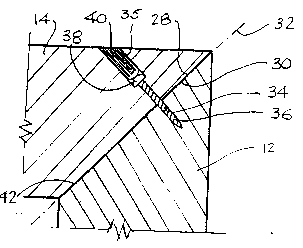Some of the information on this Web page has been provided by external sources. The Government of Canada is not responsible for the accuracy, reliability or currency of the information supplied by external sources. Users wishing to rely upon this information should consult directly with the source of the information. Content provided by external sources is not subject to official languages, privacy and accessibility requirements.
Any discrepancies in the text and image of the Claims and Abstract are due to differing posting times. Text of the Claims and Abstract are posted:
| (12) Patent Application: | (11) CA 2114099 |
|---|---|
| (54) English Title: | MITRE JOINTS IN WOOD FRAMES FOR DOORS AND THE LIKE |
| (54) French Title: | ASSEMBLAGE A ONGLET D'OSSATURES DE PORTE ET ARTICLES ANALOGUES |
| Status: | Deemed Abandoned and Beyond the Period of Reinstatement - Pending Response to Notice of Disregarded Communication |
| (51) International Patent Classification (IPC): |
|
|---|---|
| (72) Inventors : |
|
| (73) Owners : |
|
| (71) Applicants : |
|
| (74) Agent: | ADE & COMPANY |
| (74) Associate agent: | |
| (45) Issued: | |
| (22) Filed Date: | 1994-01-24 |
| (41) Open to Public Inspection: | 1995-07-25 |
| Availability of licence: | N/A |
| Dedicated to the Public: | N/A |
| (25) Language of filing: | English |
| Patent Cooperation Treaty (PCT): | No |
|---|
| (30) Application Priority Data: | None |
|---|
A mitre joint and a method and apparatus for its manufacture are disclosed
A joint between two workpieces has a hole extending through one of the workpieces and
into the other, across the line of juncture of the two workpieces, and preferably
perpendicular to the line of juncture. A screw is driven into the hole to join the
workpieces. A dowel is then inserted into the hole behind the screw and is then trimmed
to provide a flush edge surface on the workpiece. The manufacture of the joint lends itself
to automation and eliminates the clamping and setting time required with a convention
glued and doweled joint.
Note: Claims are shown in the official language in which they were submitted.
Note: Descriptions are shown in the official language in which they were submitted.

2024-08-01:As part of the Next Generation Patents (NGP) transition, the Canadian Patents Database (CPD) now contains a more detailed Event History, which replicates the Event Log of our new back-office solution.
Please note that "Inactive:" events refers to events no longer in use in our new back-office solution.
For a clearer understanding of the status of the application/patent presented on this page, the site Disclaimer , as well as the definitions for Patent , Event History , Maintenance Fee and Payment History should be consulted.
| Description | Date |
|---|---|
| Deemed Abandoned - Failure to Respond to Maintenance Fee Notice | 2002-01-24 |
| Inactive: Dead - RFE never made | 2002-01-24 |
| Application Not Reinstated by Deadline | 2002-01-24 |
| Inactive: Abandon-RFE+Late fee unpaid-Correspondence sent | 2001-01-24 |
| Application Published (Open to Public Inspection) | 1995-07-25 |
| Abandonment Date | Reason | Reinstatement Date |
|---|---|---|
| 2002-01-24 |
The last payment was received on 2000-12-20
Note : If the full payment has not been received on or before the date indicated, a further fee may be required which may be one of the following
Patent fees are adjusted on the 1st of January every year. The amounts above are the current amounts if received by December 31 of the current year.
Please refer to the CIPO
Patent Fees
web page to see all current fee amounts.
| Fee Type | Anniversary Year | Due Date | Paid Date |
|---|---|---|---|
| MF (application, 4th anniv.) - small | 04 | 1998-01-26 | 1998-01-16 |
| MF (application, 5th anniv.) - small | 05 | 1999-01-25 | 1999-01-15 |
| MF (application, 6th anniv.) - small | 06 | 2000-01-24 | 2000-01-21 |
| MF (application, 7th anniv.) - small | 07 | 2001-01-24 | 2000-12-20 |
Note: Records showing the ownership history in alphabetical order.
| Current Owners on Record |
|---|
| ELIAS WOODWORK AND MANUFACTURE LTD. |
| Past Owners on Record |
|---|
| D. RALPH FEHR |